Operating System: Core Services, Functions, and Design
VerifiedAdded on 2021/05/31
|11
|1246
|34
Homework Assignment
AI Summary
This document provides a detailed solution to an Operating System assignment, covering key concepts and functionalities. Section 1 addresses the five vital services of an OS (program execution, communications, I/O tasks, resource allocation, and error detection), and also discusses the relationship between application software and the OS. Section 2 presents solutions to a series of questions related to the comparison between Windows and Linux, multiprocessing, and batch processing. The assignment explores both GUI and CUI, multiprocessing systems, and the benefits of batch processing, while also comparing Windows and Linux operating systems, highlighting their strengths and weaknesses. The document is well-structured, includes references, and provides a comprehensive understanding of the assignment topics.
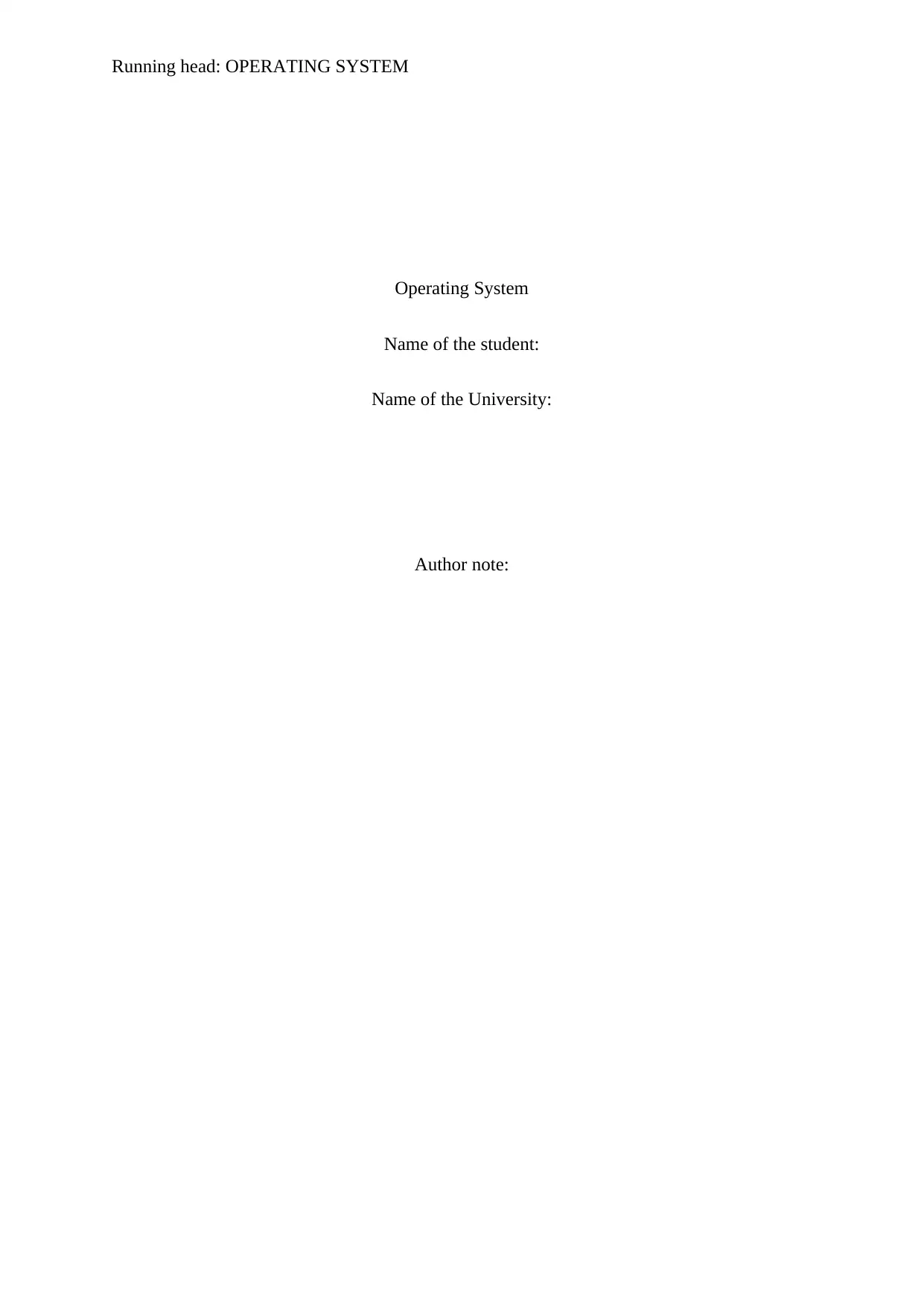
Running head: OPERATING SYSTEM
Operating System
Name of the student:
Name of the University:
Author note:
Operating System
Name of the student:
Name of the University:
Author note:
Paraphrase This Document
Need a fresh take? Get an instant paraphrase of this document with our AI Paraphraser
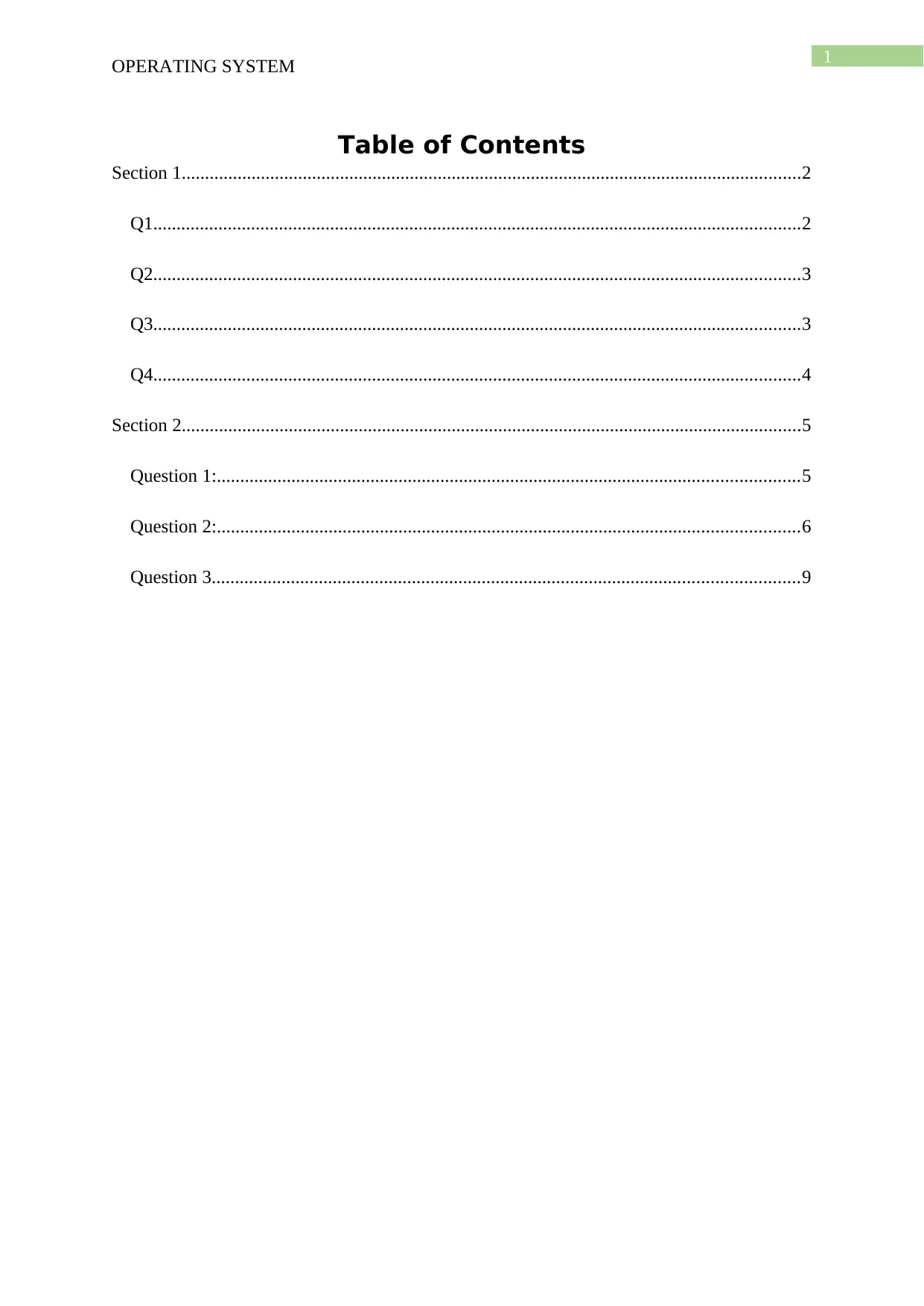
1
OPERATING SYSTEM
Table of Contents
Section 1.....................................................................................................................................2
Q1...........................................................................................................................................2
Q2...........................................................................................................................................3
Q3...........................................................................................................................................3
Q4...........................................................................................................................................4
Section 2.....................................................................................................................................5
Question 1:.............................................................................................................................5
Question 2:.............................................................................................................................6
Question 3..............................................................................................................................9
OPERATING SYSTEM
Table of Contents
Section 1.....................................................................................................................................2
Q1...........................................................................................................................................2
Q2...........................................................................................................................................3
Q3...........................................................................................................................................3
Q4...........................................................................................................................................4
Section 2.....................................................................................................................................5
Question 1:.............................................................................................................................5
Question 2:.............................................................................................................................6
Question 3..............................................................................................................................9

2
OPERATING SYSTEM
Section 1
Q1.
The five most vital services of the Operating System are:
1. Program Execution: The Operating framework gives the users a domain, for executing
programs, proficiently. The user needs not to ever stress over the low-level works like
Resource allocation, memory management and many more internal tasks.
2. Communications: In the modern multi-tasking and multi-functional environment, it is
vital for programs and processes to communicate among each other for the consistent
transaction of data or information. The OS takes the responsibility to convey
information among every one of these processes using the concept of shared memory
instances.
3. I/O task: Every program requires data as input, process handling and output
functionalities to be performed. This makes the administration of management of the
Input and output devices a pivotal duty for the Operating System. The user level
projects cannot assist in I/O-based responsibilities directly; hence, consequently, the
OS needs to assume responsibility [3].
4. Resource allocation: In multitasking situations, more than one running process may
simultaneously require similar assets like CPU, memory and more such resources. It
is then the obligation of the Operating System to run calculations or algorithms to
choose which process ought to get hold of specific resources. The time of this
allocation is also decided by the algorithms that the CPU uses.
5. Error Detection: It is the activity of the OS to recognize and manage the
programmatic or hardware-based problems of any framework. One of the obligations
of the OS is always monitor the system to detect errors or exceptions and handling
OPERATING SYSTEM
Section 1
Q1.
The five most vital services of the Operating System are:
1. Program Execution: The Operating framework gives the users a domain, for executing
programs, proficiently. The user needs not to ever stress over the low-level works like
Resource allocation, memory management and many more internal tasks.
2. Communications: In the modern multi-tasking and multi-functional environment, it is
vital for programs and processes to communicate among each other for the consistent
transaction of data or information. The OS takes the responsibility to convey
information among every one of these processes using the concept of shared memory
instances.
3. I/O task: Every program requires data as input, process handling and output
functionalities to be performed. This makes the administration of management of the
Input and output devices a pivotal duty for the Operating System. The user level
projects cannot assist in I/O-based responsibilities directly; hence, consequently, the
OS needs to assume responsibility [3].
4. Resource allocation: In multitasking situations, more than one running process may
simultaneously require similar assets like CPU, memory and more such resources. It
is then the obligation of the Operating System to run calculations or algorithms to
choose which process ought to get hold of specific resources. The time of this
allocation is also decided by the algorithms that the CPU uses.
5. Error Detection: It is the activity of the OS to recognize and manage the
programmatic or hardware-based problems of any framework. One of the obligations
of the OS is always monitor the system to detect errors or exceptions and handling
⊘ This is a preview!⊘
Do you want full access?
Subscribe today to unlock all pages.

Trusted by 1+ million students worldwide
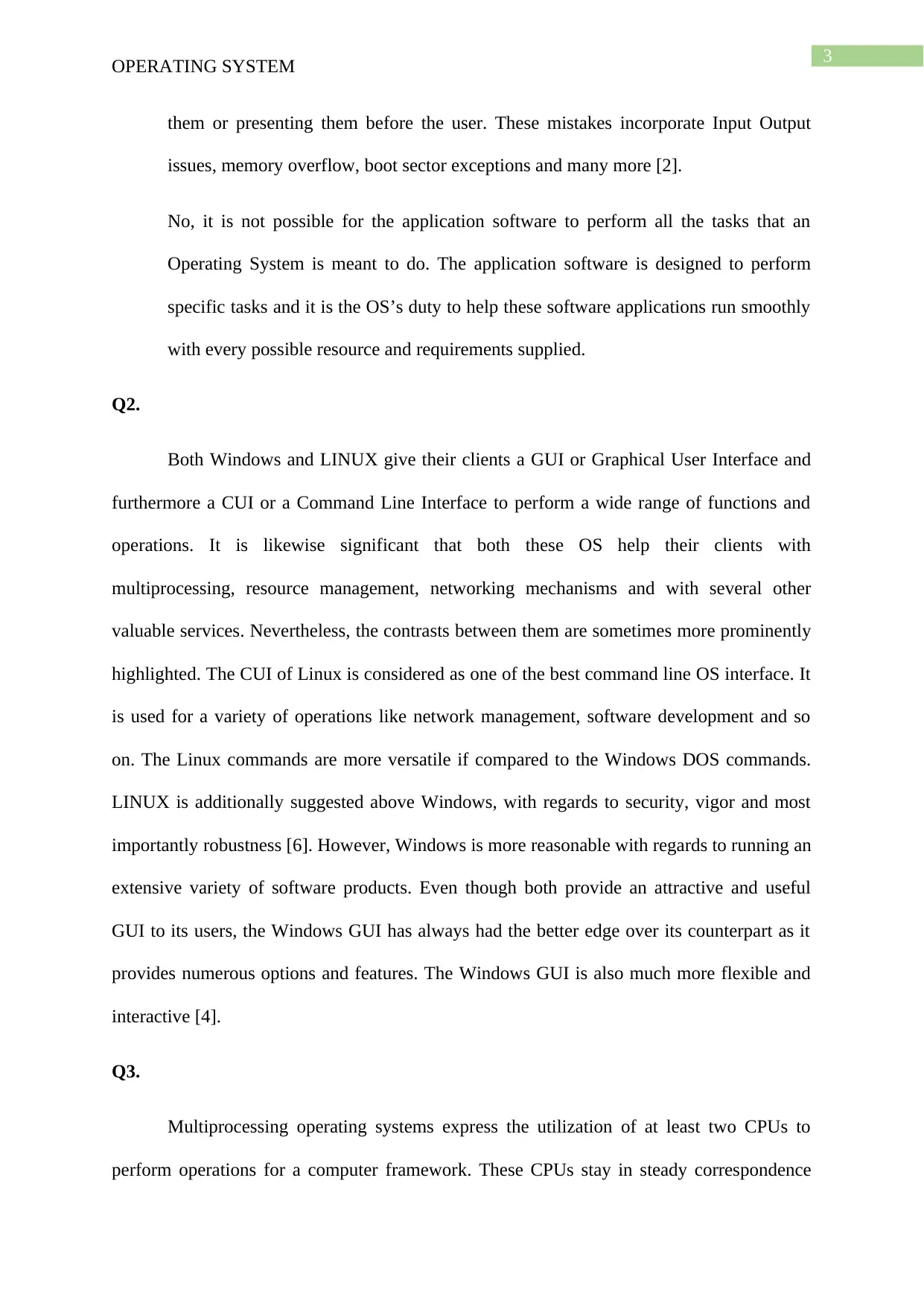
3
OPERATING SYSTEM
them or presenting them before the user. These mistakes incorporate Input Output
issues, memory overflow, boot sector exceptions and many more [2].
No, it is not possible for the application software to perform all the tasks that an
Operating System is meant to do. The application software is designed to perform
specific tasks and it is the OS’s duty to help these software applications run smoothly
with every possible resource and requirements supplied.
Q2.
Both Windows and LINUX give their clients a GUI or Graphical User Interface and
furthermore a CUI or a Command Line Interface to perform a wide range of functions and
operations. It is likewise significant that both these OS help their clients with
multiprocessing, resource management, networking mechanisms and with several other
valuable services. Nevertheless, the contrasts between them are sometimes more prominently
highlighted. The CUI of Linux is considered as one of the best command line OS interface. It
is used for a variety of operations like network management, software development and so
on. The Linux commands are more versatile if compared to the Windows DOS commands.
LINUX is additionally suggested above Windows, with regards to security, vigor and most
importantly robustness [6]. However, Windows is more reasonable with regards to running an
extensive variety of software products. Even though both provide an attractive and useful
GUI to its users, the Windows GUI has always had the better edge over its counterpart as it
provides numerous options and features. The Windows GUI is also much more flexible and
interactive [4].
Q3.
Multiprocessing operating systems express the utilization of at least two CPUs to
perform operations for a computer framework. These CPUs stay in steady correspondence
OPERATING SYSTEM
them or presenting them before the user. These mistakes incorporate Input Output
issues, memory overflow, boot sector exceptions and many more [2].
No, it is not possible for the application software to perform all the tasks that an
Operating System is meant to do. The application software is designed to perform
specific tasks and it is the OS’s duty to help these software applications run smoothly
with every possible resource and requirements supplied.
Q2.
Both Windows and LINUX give their clients a GUI or Graphical User Interface and
furthermore a CUI or a Command Line Interface to perform a wide range of functions and
operations. It is likewise significant that both these OS help their clients with
multiprocessing, resource management, networking mechanisms and with several other
valuable services. Nevertheless, the contrasts between them are sometimes more prominently
highlighted. The CUI of Linux is considered as one of the best command line OS interface. It
is used for a variety of operations like network management, software development and so
on. The Linux commands are more versatile if compared to the Windows DOS commands.
LINUX is additionally suggested above Windows, with regards to security, vigor and most
importantly robustness [6]. However, Windows is more reasonable with regards to running an
extensive variety of software products. Even though both provide an attractive and useful
GUI to its users, the Windows GUI has always had the better edge over its counterpart as it
provides numerous options and features. The Windows GUI is also much more flexible and
interactive [4].
Q3.
Multiprocessing operating systems express the utilization of at least two CPUs to
perform operations for a computer framework. These CPUs stay in steady correspondence
Paraphrase This Document
Need a fresh take? Get an instant paraphrase of this document with our AI Paraphraser
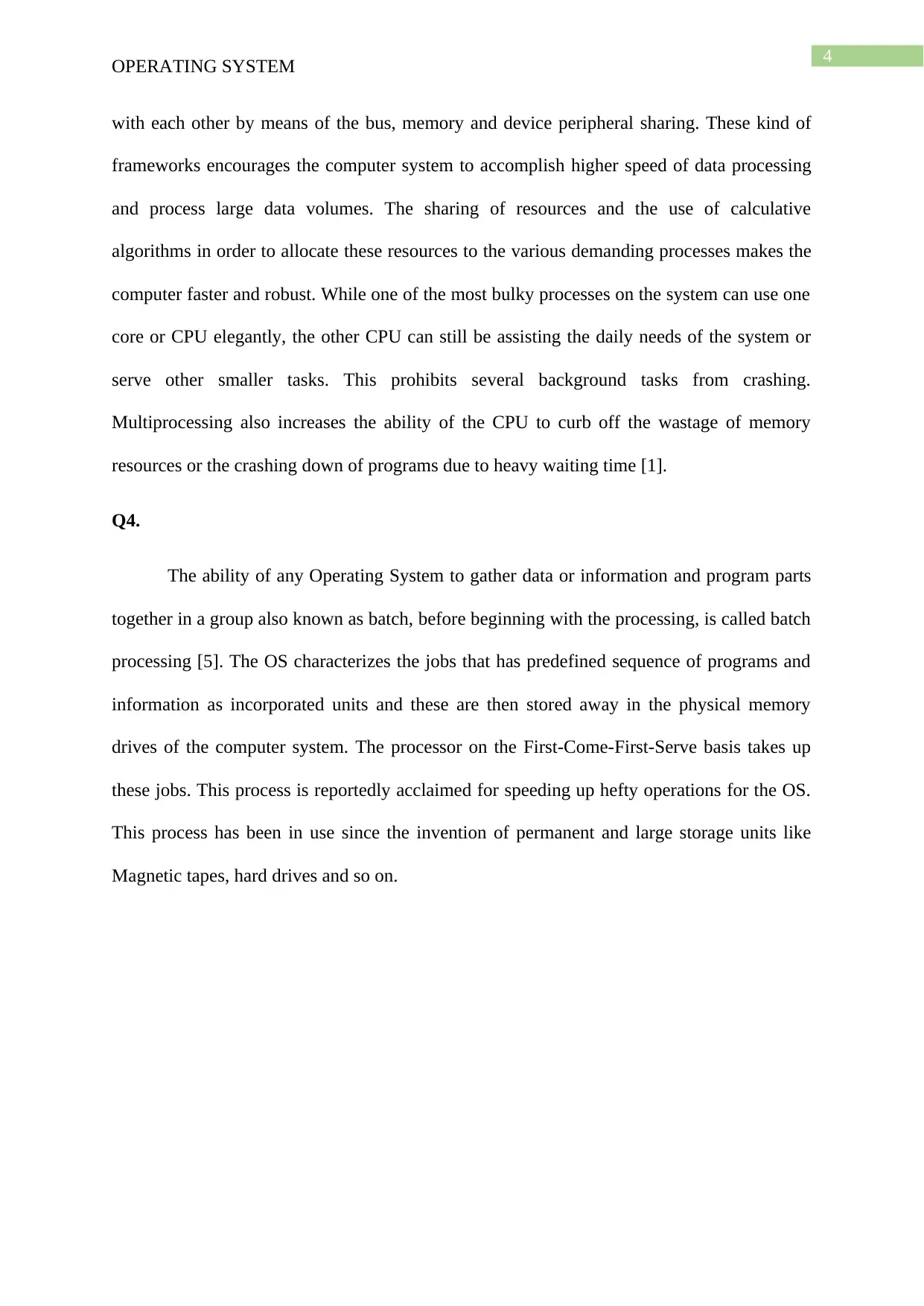
4
OPERATING SYSTEM
with each other by means of the bus, memory and device peripheral sharing. These kind of
frameworks encourages the computer system to accomplish higher speed of data processing
and process large data volumes. The sharing of resources and the use of calculative
algorithms in order to allocate these resources to the various demanding processes makes the
computer faster and robust. While one of the most bulky processes on the system can use one
core or CPU elegantly, the other CPU can still be assisting the daily needs of the system or
serve other smaller tasks. This prohibits several background tasks from crashing.
Multiprocessing also increases the ability of the CPU to curb off the wastage of memory
resources or the crashing down of programs due to heavy waiting time [1].
Q4.
The ability of any Operating System to gather data or information and program parts
together in a group also known as batch, before beginning with the processing, is called batch
processing [5]. The OS characterizes the jobs that has predefined sequence of programs and
information as incorporated units and these are then stored away in the physical memory
drives of the computer system. The processor on the First-Come-First-Serve basis takes up
these jobs. This process is reportedly acclaimed for speeding up hefty operations for the OS.
This process has been in use since the invention of permanent and large storage units like
Magnetic tapes, hard drives and so on.
OPERATING SYSTEM
with each other by means of the bus, memory and device peripheral sharing. These kind of
frameworks encourages the computer system to accomplish higher speed of data processing
and process large data volumes. The sharing of resources and the use of calculative
algorithms in order to allocate these resources to the various demanding processes makes the
computer faster and robust. While one of the most bulky processes on the system can use one
core or CPU elegantly, the other CPU can still be assisting the daily needs of the system or
serve other smaller tasks. This prohibits several background tasks from crashing.
Multiprocessing also increases the ability of the CPU to curb off the wastage of memory
resources or the crashing down of programs due to heavy waiting time [1].
Q4.
The ability of any Operating System to gather data or information and program parts
together in a group also known as batch, before beginning with the processing, is called batch
processing [5]. The OS characterizes the jobs that has predefined sequence of programs and
information as incorporated units and these are then stored away in the physical memory
drives of the computer system. The processor on the First-Come-First-Serve basis takes up
these jobs. This process is reportedly acclaimed for speeding up hefty operations for the OS.
This process has been in use since the invention of permanent and large storage units like
Magnetic tapes, hard drives and so on.
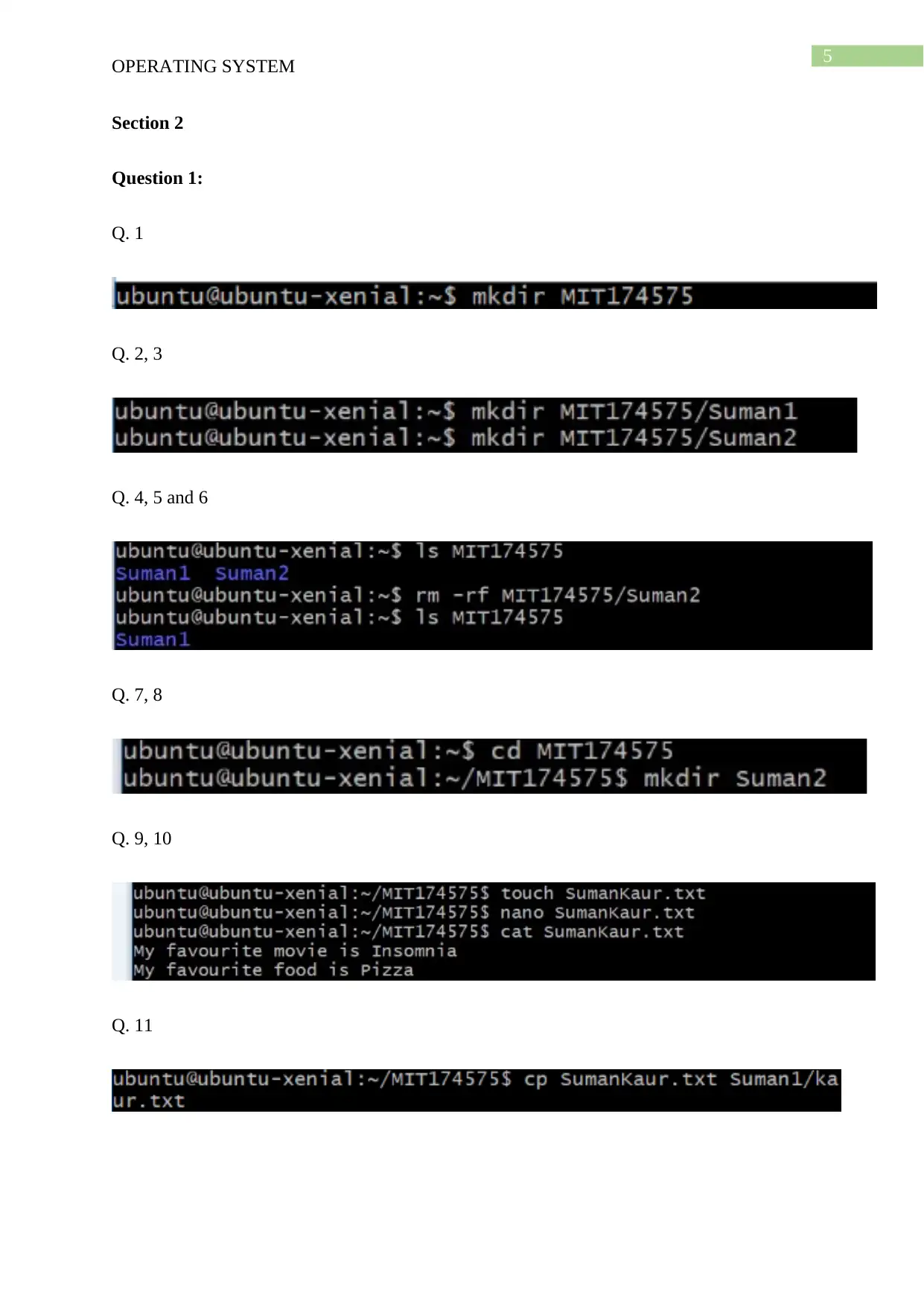
5
OPERATING SYSTEM
Section 2
Question 1:
Q. 1
Q. 2, 3
Q. 4, 5 and 6
Q. 7, 8
Q. 9, 10
Q. 11
OPERATING SYSTEM
Section 2
Question 1:
Q. 1
Q. 2, 3
Q. 4, 5 and 6
Q. 7, 8
Q. 9, 10
Q. 11
⊘ This is a preview!⊘
Do you want full access?
Subscribe today to unlock all pages.

Trusted by 1+ million students worldwide
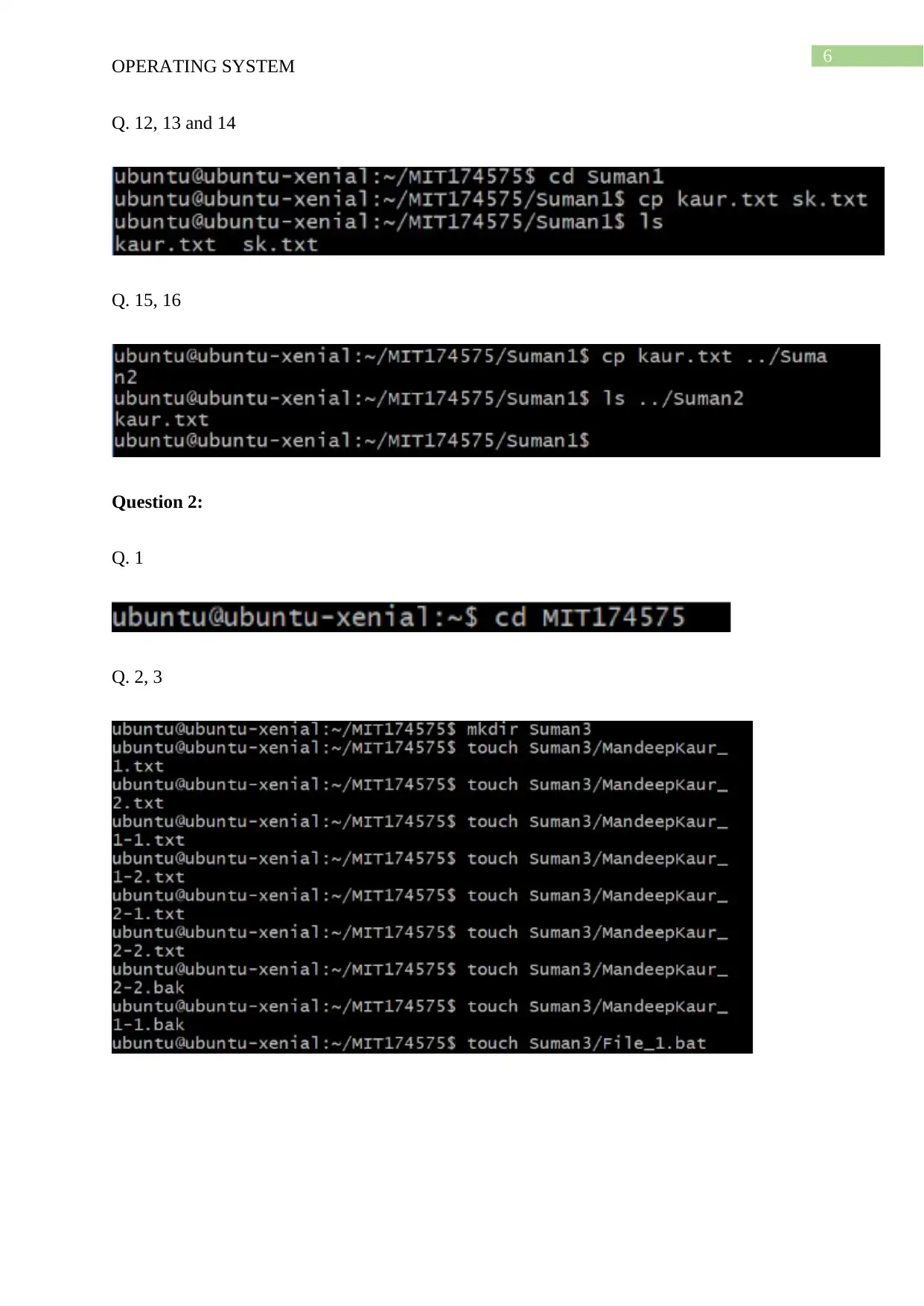
6
OPERATING SYSTEM
Q. 12, 13 and 14
Q. 15, 16
Question 2:
Q. 1
Q. 2, 3
OPERATING SYSTEM
Q. 12, 13 and 14
Q. 15, 16
Question 2:
Q. 1
Q. 2, 3
Paraphrase This Document
Need a fresh take? Get an instant paraphrase of this document with our AI Paraphraser
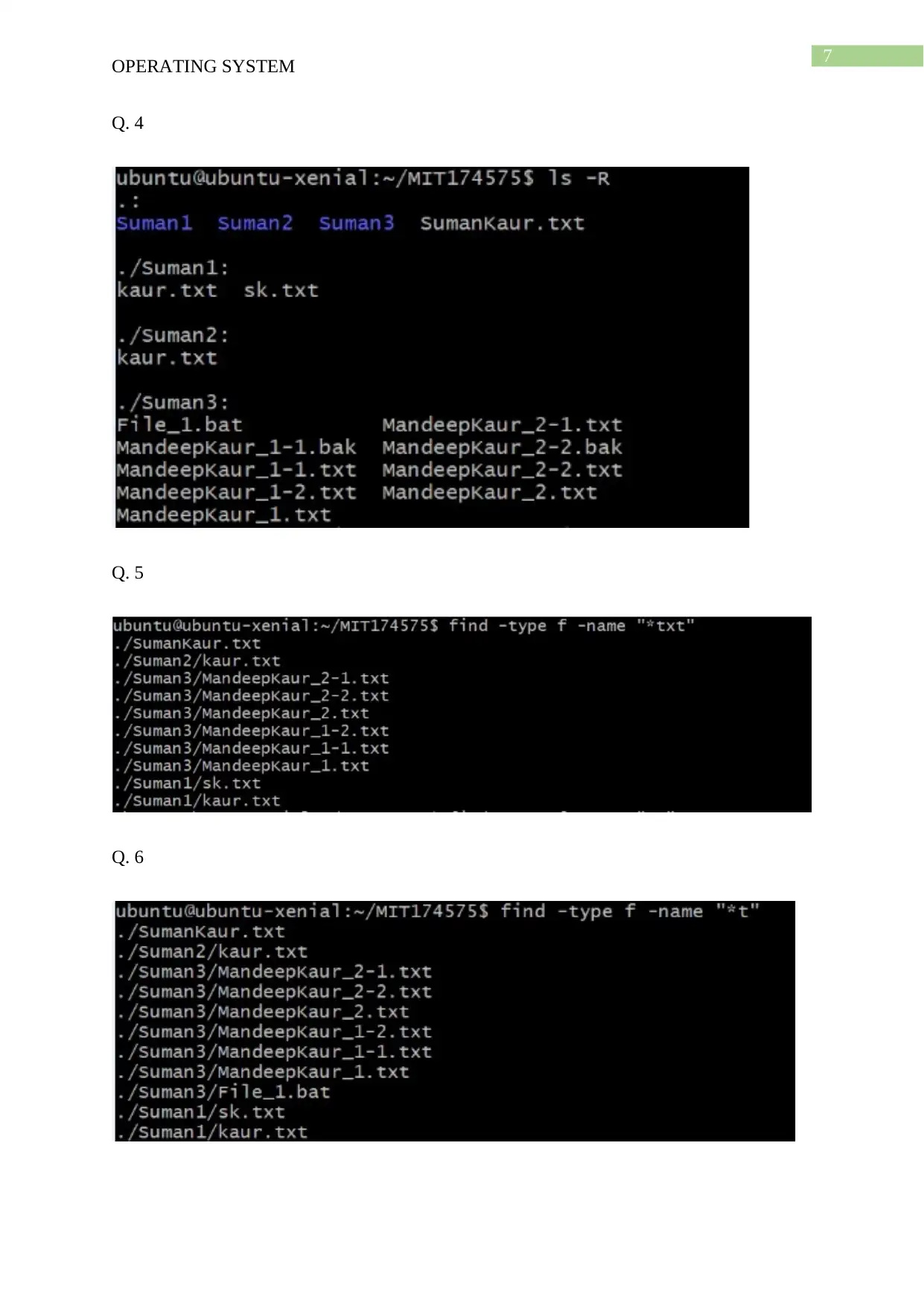
7
OPERATING SYSTEM
Q. 4
Q. 5
Q. 6
OPERATING SYSTEM
Q. 4
Q. 5
Q. 6
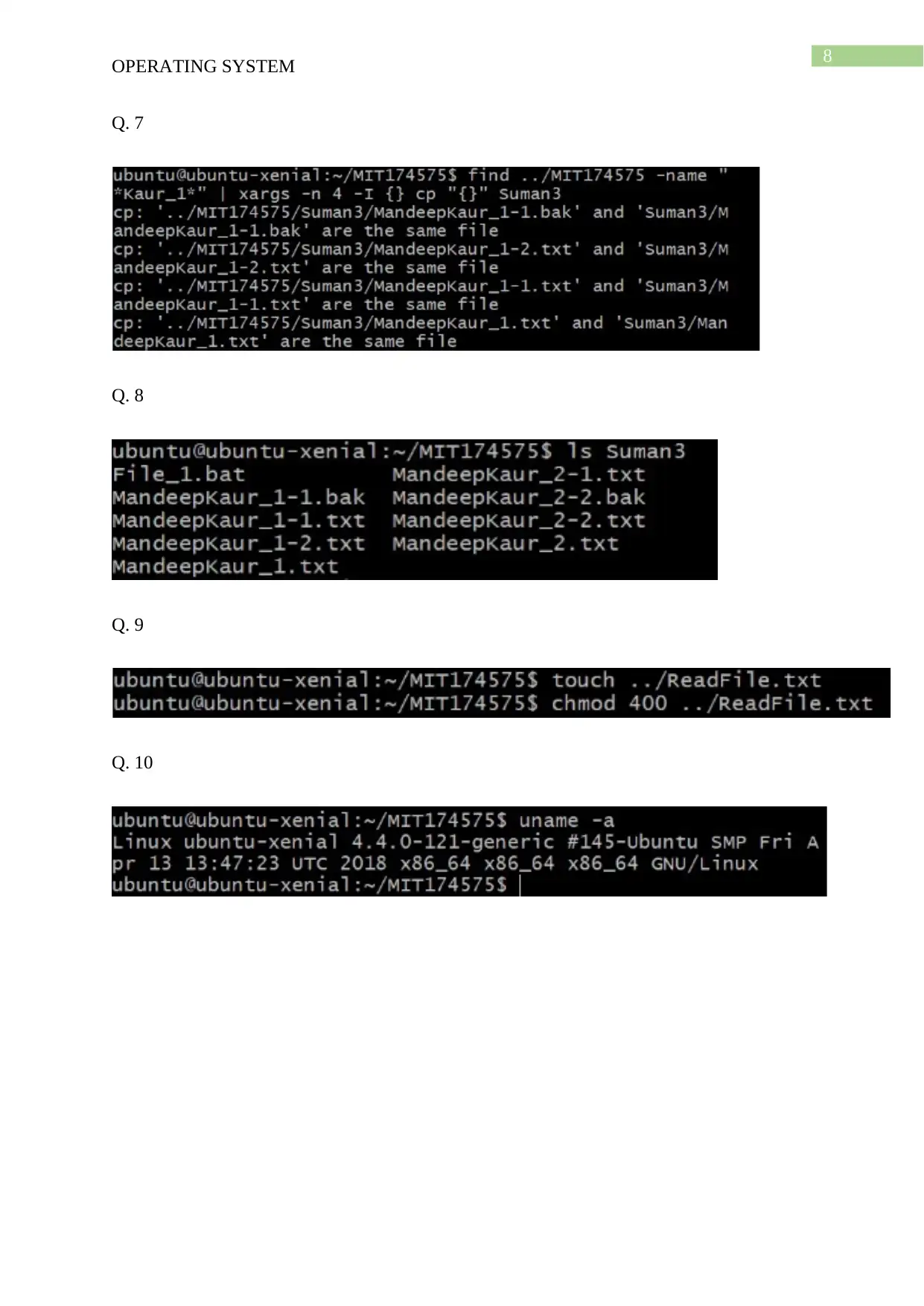
8
OPERATING SYSTEM
Q. 7
Q. 8
Q. 9
Q. 10
OPERATING SYSTEM
Q. 7
Q. 8
Q. 9
Q. 10
⊘ This is a preview!⊘
Do you want full access?
Subscribe today to unlock all pages.

Trusted by 1+ million students worldwide
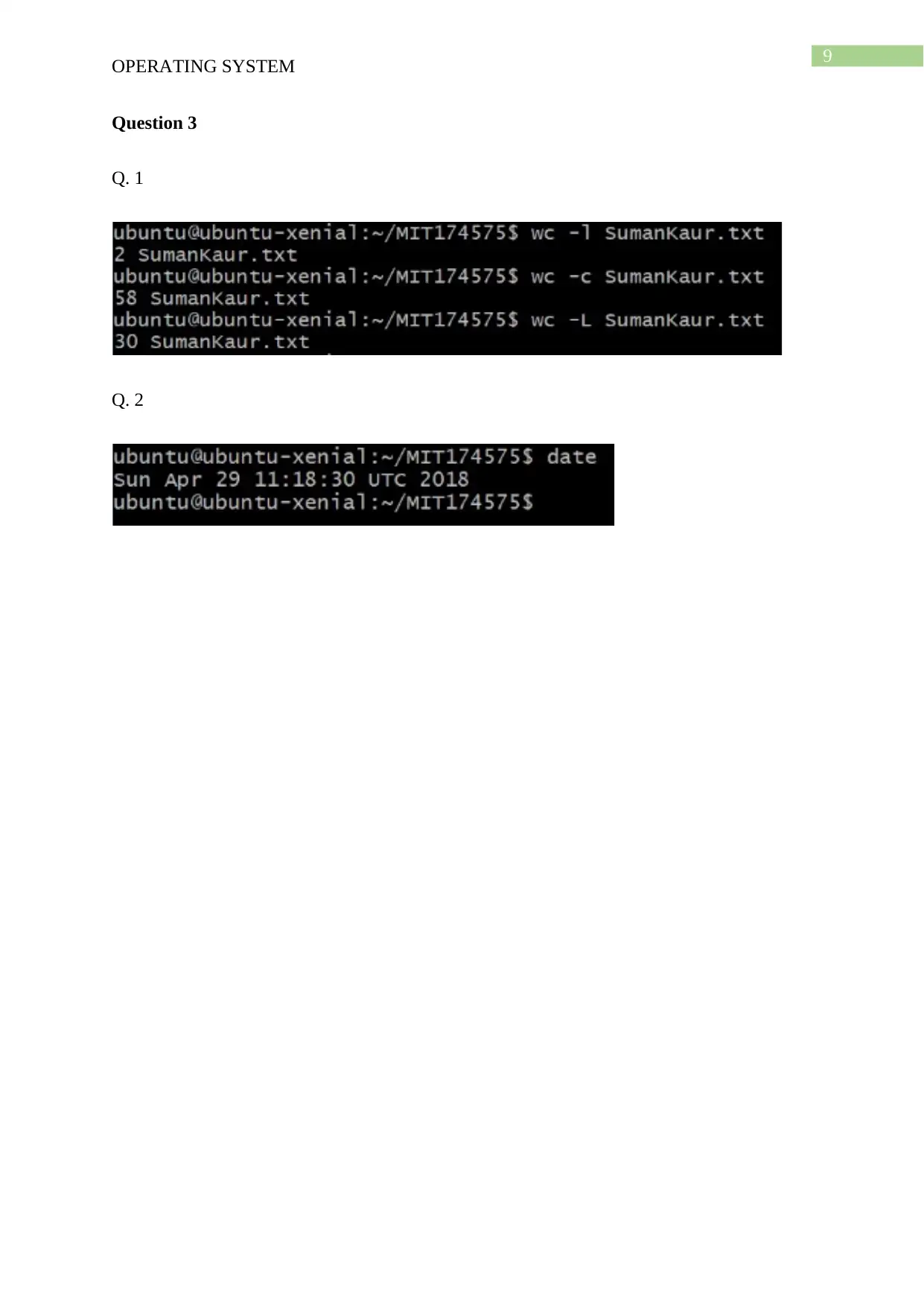
9
OPERATING SYSTEM
Question 3
Q. 1
Q. 2
OPERATING SYSTEM
Question 3
Q. 1
Q. 2
Paraphrase This Document
Need a fresh take? Get an instant paraphrase of this document with our AI Paraphraser

10
OPERATING SYSTEM
References
[1] Wolf, Marilyn. High-performance embedded computing: applications in cyber-physical
systems and mobile computing. Newnes, 2014.
[2] Silberschatz, Abraham, Peter Baer Galvin, and Greg Gagne. Operating system concepts
essentials. John Wiley & Sons, Inc., 2014.
[3] Peter, Simon, Jialin Li, Irene Zhang, Dan RK Ports, Doug Woos, Arvind Krishnamurthy,
Thomas Anderson, and Timothy Roscoe. "Arrakis: The operating system is the control
plane." ACM Transactions on Computer Systems (TOCS) 33, no. 4 (2016): 11.
[4] Lee, Sang-Hyuk, and Seung-Hyun Oh. "A kinect sensor based windows control
interface,”." International Journal of Control and Automation 7, no. 3 (2014): 113-124.
[5] Bonomi, Flavio, Rodolfo Milito, Jiang Zhu, and Sateesh Addepalli. "Fog computing and
its role in the internet of things." In Proceedings of the first edition of the MCC workshop on
Mobile cloud computing, pp. 13-16. ACM, 2012.
[6] Uitto, Joni, Sampsa Rauti, Jari-Matti Mäkelä, and Ville Leppänen. "Preventing malicious
attacks by diversifying Linux shell commands." In SPLST, pp. 206-220. 2015.
OPERATING SYSTEM
References
[1] Wolf, Marilyn. High-performance embedded computing: applications in cyber-physical
systems and mobile computing. Newnes, 2014.
[2] Silberschatz, Abraham, Peter Baer Galvin, and Greg Gagne. Operating system concepts
essentials. John Wiley & Sons, Inc., 2014.
[3] Peter, Simon, Jialin Li, Irene Zhang, Dan RK Ports, Doug Woos, Arvind Krishnamurthy,
Thomas Anderson, and Timothy Roscoe. "Arrakis: The operating system is the control
plane." ACM Transactions on Computer Systems (TOCS) 33, no. 4 (2016): 11.
[4] Lee, Sang-Hyuk, and Seung-Hyun Oh. "A kinect sensor based windows control
interface,”." International Journal of Control and Automation 7, no. 3 (2014): 113-124.
[5] Bonomi, Flavio, Rodolfo Milito, Jiang Zhu, and Sateesh Addepalli. "Fog computing and
its role in the internet of things." In Proceedings of the first edition of the MCC workshop on
Mobile cloud computing, pp. 13-16. ACM, 2012.
[6] Uitto, Joni, Sampsa Rauti, Jari-Matti Mäkelä, and Ville Leppänen. "Preventing malicious
attacks by diversifying Linux shell commands." In SPLST, pp. 206-220. 2015.
1 out of 11
Related Documents
Your All-in-One AI-Powered Toolkit for Academic Success.
+13062052269
info@desklib.com
Available 24*7 on WhatsApp / Email
![[object Object]](/_next/static/media/star-bottom.7253800d.svg)
Unlock your academic potential
Copyright © 2020–2025 A2Z Services. All Rights Reserved. Developed and managed by ZUCOL.





